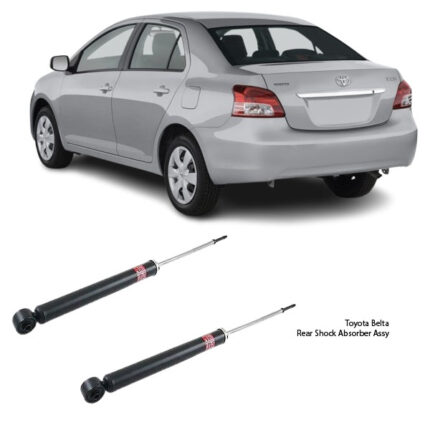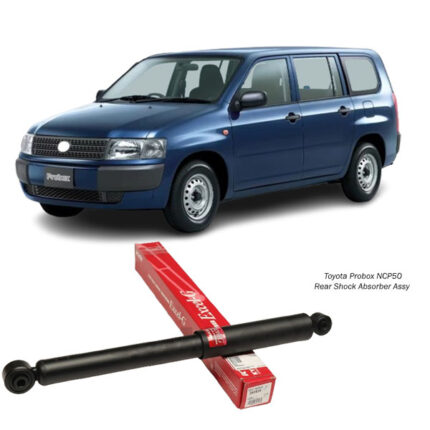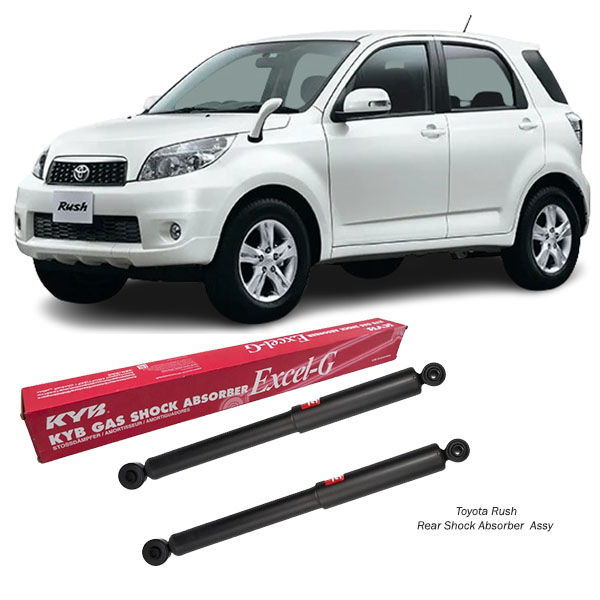-5%
Get Toyota Rush J200 Rear Shock Absorber Assy RH/LH 343441 in Kenya
The rear shock absorber assembly is a crucial part of a vehicle’s suspension system, ensuring a smooth ride by absorbing shocks and dampening vibrations. It is responsible for maintaining stability, comfort, and safety.
The abbreviations RH (Right-Hand) and LH (Left-Hand) indicate the positioning of the shock absorbers on the right and left sides of the rear axle. These components work in pairs, ensuring balanced performance. 🚘
2. Function of a Rear Shock Absorber 🛞
The primary role of a rear shock absorber is to control the movement of the suspension system by reducing excessive bouncing after hitting a bump. Without shock absorbers, the vehicle would feel unstable and difficult to handle. 🚦
Key Functions:
✔ Absorbs shocks from road irregularities (potholes, speed bumps, rough terrains).
✔ Enhances ride comfort by minimizing vibrations and jolts.
✔ Improves vehicle handling by maintaining tire contact with the road.
✔ Prevents excessive suspension movement, reducing strain on other parts.
✔ Reduces tire wear by ensuring even road contact.
💡 A well-functioning shock absorber keeps your car steady, preventing excessive swaying and bouncing!
3. Components of a Rear Shock Absorber Assembly 🔩
A shock absorber assembly is made up of several essential parts, each playing a specific role in the damping process. Let’s break them down:
1️⃣ Shock Absorber Body
- The outer casing that houses the internal components.
- Made from high-strength steel to withstand high pressure.
2️⃣ Piston & Piston Rod
- Moves up and down inside the shock absorber, pushing fluid to control movement.
- The piston rod connects to the vehicle’s chassis, transferring motion to the absorber.
3️⃣ Hydraulic Fluid (Oil) & Gas Chamber
- Oil-filled shock absorbers use hydraulic resistance to control movement.
- Gas-charged shocks use nitrogen gas to prevent foaming, improving damping.
4️⃣ Valve System
- Controls oil flow, adjusting damping force based on road conditions.
- Advanced designs have adjustable valves for different ride preferences.
5️⃣ Mounting Bushings & Brackets
- Rubber bushings absorb minor vibrations and reduce noise.
- Mounting brackets attach the shock absorber securely to the vehicle frame.
🚧 A failure in any of these parts can lead to reduced performance or total failure of the shock absorber.
4. Types of Rear Shock Absorbers 🛠️
Shock absorbers come in different types, each suited for specific vehicles and driving conditions.
1️⃣ Hydraulic Shock Absorbers 💦
- Uses oil to absorb shock forces.
- Common in standard passenger cars.
2️⃣ Gas-Charged Shock Absorbers 🏎️
- Uses compressed nitrogen gas to prevent oil foaming.
- Enhances performance in sports and high-performance vehicles.
3️⃣ Twin-Tube Shock Absorbers 📏
- Has two cylinders (inner and outer).
- Provides soft damping, ideal for comfort-oriented vehicles.
4️⃣ Mono-Tube Shock Absorbers 🚀
- Uses a single large cylinder, offering better heat dissipation.
- Common in off-road and performance cars.
5️⃣ Adjustable Shock Absorbers ⚙️
- Allows manual or electronic adjustment for different driving styles.
- Found in luxury and sports vehicles.
🛑 Choosing the right type depends on your vehicle type, driving style, and road conditions.
5. Common Issues & Symptoms of a Failing Rear Shock Absorber ⚠️
Over time, shock absorbers wear out due to constant stress. Here are common signs that indicate it’s time for a replacement:
🔴 Excessive Bouncing: If your car bounces multiple times after hitting a bump, the shocks are worn out.
🔴 Unstable Handling: Poor road grip, swaying during turns, or nose-diving while braking.
🔴 Uneven Tire Wear: Worn-out shocks cause irregular tire contact, leading to bald spots.
🔴 Leaking Hydraulic Fluid: If you see oil leaks on the shock absorber, it’s failing.
🔴 Knocking or Clunking Noises: Worn-out bushings and internal components can cause metallic sounds.
🔴 Longer Stopping Distance: Reduced damping can affect braking efficiency.
🚨 Ignoring these symptoms can lead to safety hazards and expensive repairs!
6. Maintenance & Replacement Tips 🛠️
Maintaining your shock absorbers ensures a smooth and safe ride. Here’s how to take care of them:
✅ Regular Inspections
- Check for oil leaks, rust, and physical damage.
- Inspect bushings and mounting brackets for wear.
✅ Test for Bounce
- Press down on the rear of the vehicle and release it.
- If it bounces more than twice, the shocks may be worn out.
✅ Follow Manufacturer Guidelines
- Most shock absorbers last 50,000 to 100,000 miles, but driving conditions affect lifespan.
✅ Replace in Pairs
- Always replace both RH and LH shocks together for balanced performance.
✅ Professional Installation
- DIY replacement is possible, but professional installation ensures proper alignment and safety.
⚙️ Good maintenance extends the life of your shocks and improves overall vehicle performance!
7. Benefits of Replacing Worn-Out Rear Shock Absorbers 🚀
Upgrading or replacing old shocks provides several advantages:
✔ Smoother Ride: Eliminates bouncing and vibrations.
✔ Better Handling: Improves cornering stability and braking.
✔ Increased Safety: Reduces risk of skidding and loss of control.
✔ Longer Tire Life: Prevents uneven wear, saving you money.
✔ Enhanced Fuel Efficiency: Reduces excess drag from instability.
🏆 New shock absorbers make your car feel brand new!
8. Conclusion 🏁
The Rear Shock Absorber Assembly (RH/LH) is essential for a comfortable, stable, and safe driving experience. Whether you’re driving on city streets or rough terrain, well-maintained shocks make a huge difference. Regular inspections, timely replacements, and choosing the right type will ensure a smooth and secure ride.
Follow us on Facebook for more parts.



